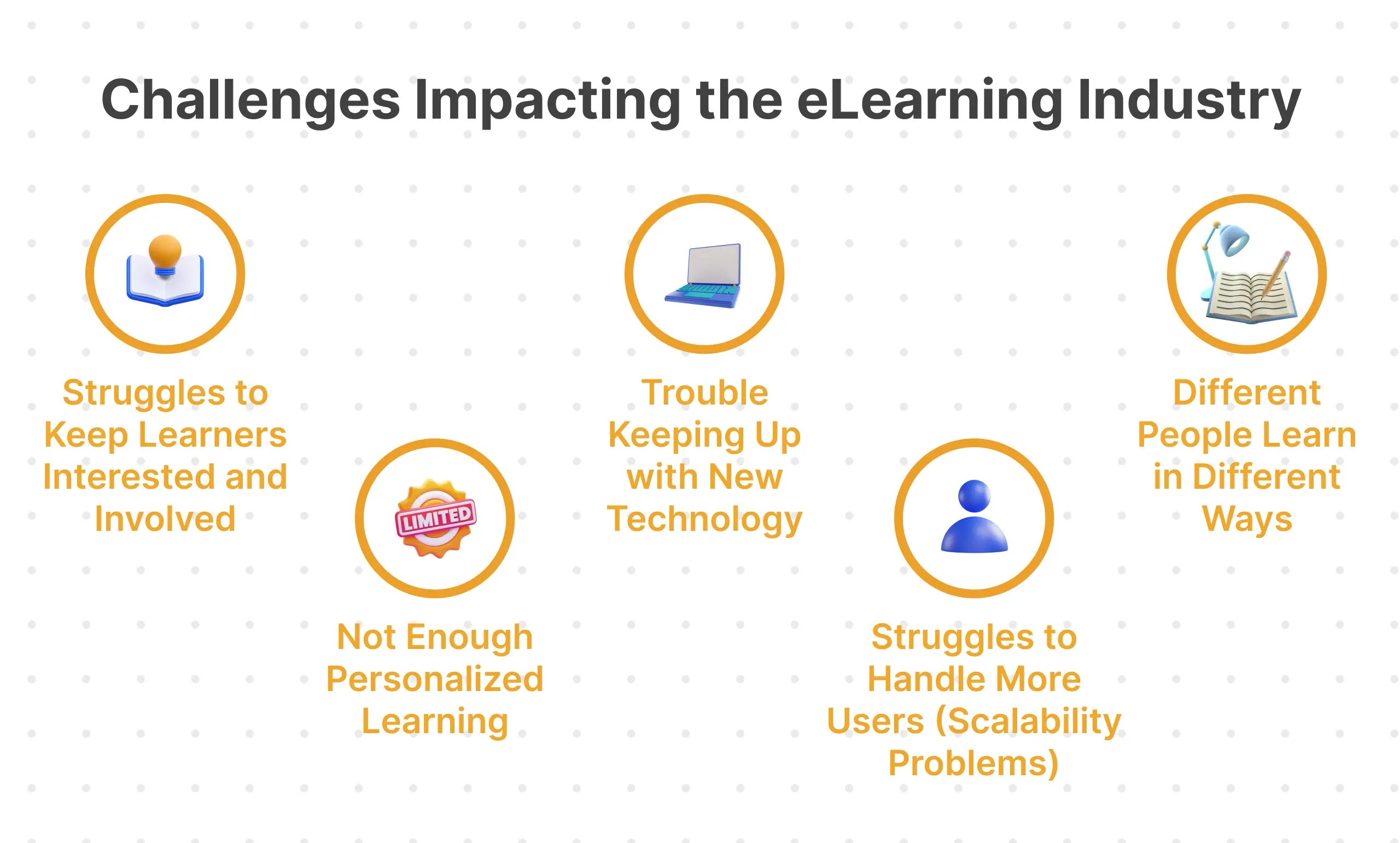Discover the top challenges facing the eLearning industry and explore innovative solutions from AI personalization to cloud scalability that help overcome barriers and drive growth in online education.

The eLearning industry has experienced rapid growth in recent years, driven by advances in digital transformation in education and the rising demand for flexible, accessible, and accessible learning solutions. From schools to companies, more people are using digital tools to teach and learn. But while eLearning brings many benefits like flexibility and easy access, it also comes with a set of real challenges that need to be solved.
Some of these problems include poor internet access, low student engagement, and difficulties using learning platforms. Others struggle with making sure courses work well for large groups or adapting to new technology. In this blog, we’ll talk about the biggest eLearning industry challenges and what can be done to fix them, so that online education becomes better and more useful for everyone.
As the demand for digital education continues to rise, the eLearning sector faces several critical challenges that impact adoption, effectiveness, and long-term scalability.

One of the biggest challenges for eLearning platforms is keeping learners interested. Studies show that more than half of people (52%) don’t finish their online courses. Why? Because the lessons often lack motivation, personalization, and interaction.
Did you know the average attention span of a learner is only 10 to 15 minutes? If the content doesn’t grab their attention right away, they’ll likely lose interest fast.
This shows that old-fashioned teaching methods just don’t work in today’s digital world. Modern learners expect more engaging, interactive, and personalized learning experiences not just plain slides or long lectures.
In eLearning, the personalization isn’t a nice-to-have, it’s a must. But many platforms still use old systems that can’t adjust to each learner’s needs or learning style. This lack of personalization often leaves learners feeling disconnected, bored, and more likely to drop out.
On the other hand, companies that offer customized learning paths saw great results, a 40% increase in employee engagement and a 20% boost in productivity, according to a recent survey. This proves that when learning feels more personal, people are more motivated and successful.
Many eLearning platforms struggle to keep up with new technologies. Whether it’s making content mobile-friendly or adding tools like AI or augmented reality, updating platforms isn’t always easy.
A big reason is cost. Upgrading systems or adding new tech can be very expensive. Smaller platforms may not be able to afford it, while larger ones risk losing quality or breaking features when they make big changes. This makes it hard for many platforms to stay modern and meet the growing expectations of today’s learners.
As more businesses and schools move online, scalability has become a major challenge for eLearning platforms. Many systems can’t handle a large number of users at once. This often leads to slow performance or crashes, which frustrates learners and hurts the platform’s reputation.
For growing organizations, not being able to scale properly can block future growth. If the platform can’t keep up with demand, it becomes harder to support more learners or expand programs over time.
Not everyone learns the same way and eLearning platforms need to support those differences. Some people are visual learners, others prefer to listen, and some learn best by doing things themselves.
If a platform only uses one method, many learners may fall behind. That’s why offering a mix of content like videos, audio, quizzes, and interactive activities is so important. This isn’t just a nice feature; it’s something every good platform should have to help learners succeed in their way.

Now that we’ve covered the main challenges in eLearning, let’s focus on how to solve them. In this section, we’ll explore modern strategies that can help businesses thrive in today’s competitive eLearning world.
Many platforms now use mobile apps with gamified features. These apps make learning available anytime, anywhere and they often feel more interactive. Learners can pick up where they left off, complete daily challenges, and get instant feedback right on their phones.
Let’s be honest no one wants to take a course that doesn’t match their needs. That’s where AI (Artificial Intelligence) and machine learning come in. These smart tools can track how a learner is doing and adjust the content to fit their level just like having a personal tutor, but for everyone.
If someone is struggling, the system can slow down or give extra help. If they’re doing well, they can move faster or offer more advanced material. This makes learning more effective and more enjoyable.
For businesses, this is a big win. Personalized learning means learners are more likely to stay engaged, finish courses, and come back for more which means better results and more revenue in the long run.
These days, data is everything and the more you use it, the better your results can be. eLearning platforms, like Learning Management Systems (LMS), collect data on how learners interact with your content.
By using this data, you can see what’s working, what’s not, and where learners may be struggling. This helps you make smart changes to improve the learning experience.
When learners get better results, they’re more likely to be happy and happy learners come back. Even better, they may recommend your platform to others, which can lead to more users and more growth for your business.
One big problem with eLearning platforms is handling sudden growth. What if lots of new users sign up at once? Some platforms slow down or crash when this happens.
That’s where cloud technology helps. With cloud-based systems, you can easily add more space and power without needing expensive hardware or physical servers. This means your platform can handle more users smoothly, helping you grow your business without big upfront costs.
Everyone learns in different ways some people like to watch videos, others prefer listening, and some learn best by doing. That’s why adaptive learning is so important.
With the help of AI-powered tools, eLearning platforms can adjust the course content based on how each person learns best. It can offer videos, infographics, podcasts, or interactive activities depending on what works for the learner.
This makes learning more effective and enjoyable. When people get the content in the way that suits them, they stay engaged, remember more, and learn faster, which is great for both learners and businesses.
Even though the eLearning industry has some challenges, it’s also full of new and exciting chances to grow. As more people turn to online learning for school, work, and personal growth, there are many ways for businesses to stand out and succeed.
From offering specialized courses to using new technologies like AI and Virtual Reality, the eLearning space is quickly changing and it’s a great time to take advantage of what’s coming next.

The way people learn is changing fast. Today, most learners use their phones or tablets to access content. That’s why creating mobile-friendly courses is so important. It lets people learn anytime, anywhere, whether they’re at home, at work, or on the move.
Even better, when you combine this with microlearning short and focused lessons you create content that’s easy to understand and quick to finish. This approach not only helps learners stay engaged but also helps your course stand out in a crowded market and reach more people.
It’s a win for both your users and your business.
eLearning isn’t just for students anymore companies are now using it to train their employees. More and more businesses are investing in online training to improve their teams’ skills, which means there’s a huge opportunity for eLearning providers.
By offering corporate training packages, you can tap into a new market and create steady income through long-term business contracts. If you’re not offering training solutions for companies yet, you could be missing out on a big source of revenue.
Using AR (Augmented Reality) and VR (Virtual Reality) in eLearning can turn a regular lesson into a fun, hands-on experience. These technologies make learning feel more real and interactive, which helps learners stay focused and better understand complex topics.
AR/VR is especially useful in fields like healthcare, engineering, and safety training, where people need practical experience. Companies that start using this now can stay ahead of the curve and be part of the future of learning.
The eLearning market is global, and people from all over the world are looking for quality online courses. If your content is only in one language, you’re missing a big opportunity.
By translating your courses into different languages, you can connect with more learners, grow your audience, and increase your income. It’s a simple step that can lead to major business growth.
Artificial Intelligence (AI) is changing the way we build learning content. With AI tools, you can create personalized lessons quickly and at a lower cost. This saves both time and money.
For businesses, this means you can launch new courses faster, reach more learners, and stay ahead of your competition. The faster you deliver, the faster your business can grow.
The eLearning industry has grown rapidly, but with that growth comes a range of challenges–from low learner engagement and scalability issues to problems in e-learning implementation and adapting to emerging technologies. These elearning industry challenges can slow down progress if not addressed strategically.
However, with the right approach like using AI for personalization, adopting mobile-first strategies, and using cloud technology businesses and educators can turn these challenges into opportunities. By staying up to date with online education trends and embracing innovation, you can overcome barriers to e-learning adoption and create impactful, scalable learning experiences.
As digital transformation in education continues, those who adapt and evolve will lead the way in shaping the future of learning.
Divyesh Savaliya
Divyesh Savaliya
Divyesh Savaliya